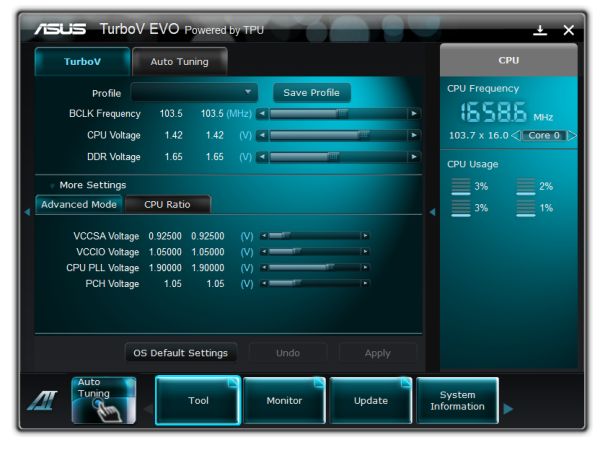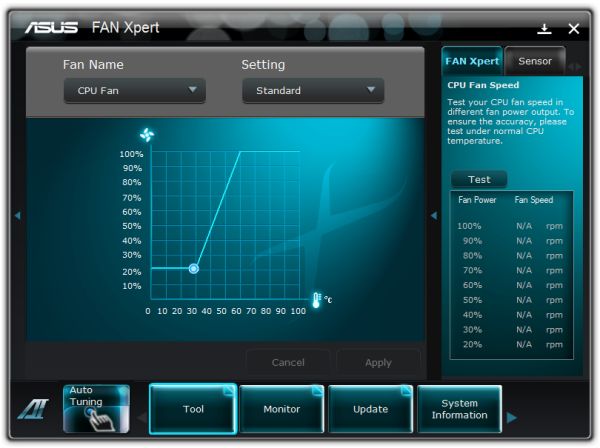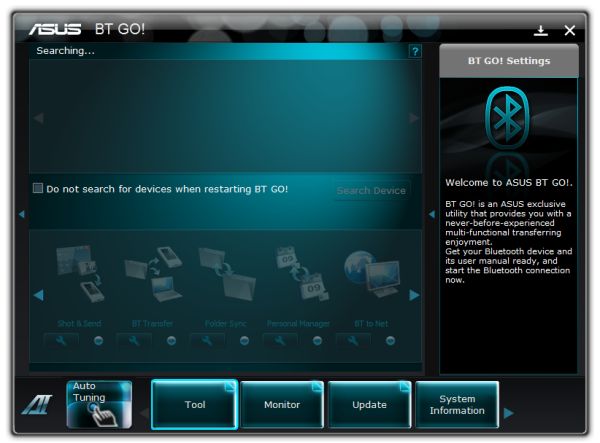The Battle of the P67 Boards - ASUS vs. Gigabyte at $190
by Ian Cutress on January 20, 2011 4:15 PM EST- Posted in
- Motherboards
- Gigabyte
- Asus
- P67
Board Features
| ASUS P8P67 Pro | |
| Market Segment | Performance |
| CPU Interface | LGA 1155 |
| CPU Support | i3/i5/i7 Sandy Bridge |
| Chipset | P67 |
| Base Clock Frequency | 100 MHz, 80 MHz to 300 MHz in 0.1 MHz intervals |
| DDR3 Memory Speed | 1333 MHz by default, 800-2133 MHz supported |
| Core Voltage | Auto, 0.800V to 1.990V in 0.005V intervals |
| CPU Clock Multiplier | Dependant on CPU |
| DRAM Voltage | Auto, 1.20V to 2.20V in 0.00625V intervals |
| DRAM Command Rate | Auto, 1N to 3N |
| Memory Slots |
Four 240-pin DDR3 DIMM slots in dual-channel Regular unbuffered DD3 memory Up to 32GB total supported |
| Expansion Slots |
3 x PCI Express 2.0 x16 slots (PCIe 1 and 2 operate at x16 in single mode or x8/x8 in dual; PCIe 3 operates in x4 mode) 2 x PCI Express 2.0 x1 slots 2 x PCI slots Supports ATI Crossfire Supports NVIDIA SLI |
| Onboard SATA/RAID |
2 x SATA 6.0 Gb/s ports (gray) supporting RAID 0, 1, 5 and 10 4 x SATA 3.0 Gb/s ports (blue) supporting RAID 0, 1, 5 and 10 2 x SATA 6.0 Gb/s ports (navy blue) from Marvell 9120 (No RAID) 2 x eSATA 3.0 Gb/s ports (1 x Power eSATA) from JMicron JMB362 |
| Onboard |
4 x SATA 3 Gb/s w/ RAID 4 x SATA 6 Gb/s (2 w/ RAID) 1 x USB 3.0/2.0 connector supports additional 2 USB ports (19-pin) 3 x USB 2.0/1/1 connectors support additional 6 USB ports 1 x IEEE1394a connector Front panel audio connector 1 x S/PDIF Out Header System Panel(Q-Connector) 1 x MemOK! Button 1 x EPU switch 1 x TPU switch |
| Onboard LAN | Intel® 82579 Gigabit Ethernet |
| Onboard Audio | Realtek® ALC892 8-Channel HD Audio |
| Power Connectors | 24-pin EATX Power connector 8-pin EATX 12V Power connector |
| Fan Headers |
1 x CPU Fan connector (4-pin) 2 x Chassis Fan connectors (1 x 4-pin; 1 x 3-pin) 1 x Power Fan connector (3-pin) |
| I/O Panel |
1 x PS/2 Mouse port (green) 1 x PS/2 Keyboard port (purple) 1 x Coaxial S/PDIF Out port 1 x Optical S/PDIF Out port 1 x Bluetooth module 2 x eSATA ports (1 x Power eSATA) 1 x IEEE1394a port 1 x LAN (RJ45) ports 2 x USB 3.0/2.0 ports (blue) 6 x USB 2.0/1.1 ports 8-channel Audio I/O ports |
| UEFI Revision | 1053 (Release UEFI) |
In the Box
- I/O shield
- USB 3.0 rear bracket
- SLI 2-slot bridge
- 4 x right-angled SATA connectors
The USB 3.0 rear bracket connects in the board to the USB 3.0 header, and stretches across the GPUs and intended for the bracket position between the PCIe slots. The cord is just long enough for this, but this kit will not reach to other bracket positions if you already require that PCI slot between the PCIe slots and both PCIe x16 slots for GPUs.
Software
ASUS Ai Suite II
ASUS have wrapped all their OS features into one overall program, called Ai Suite II. Through this program, you can overclock, auto tune, enable/disable EPU, control the VRMs, control the fans, and update the UEFI. In my experience, it works rather well.
Ai Suite II initially comes up as a toolbar, and selecting one of the buttons creates a popup menu, from which you select the feature you want to use. This is a roundabout way of doing it; I would have preferred a tabbed system personally. The first screen is the TurboV EVO module, the heart of the TPU. On the fly BCLK, voltages, and CPU ratios are applicable here. Increasing various parameters results in them turning yellow, to see that they are all changed, and on clicking apply, all modifications are made. The only downside of this overclocking mode is in the inability to modify the RAM sub-timings on the fly.
The auto-tuning section is a one-button click. The program then restarts the computer, loads into the OS a couple of times, and stability tests the system. I like this feature – the i5-2500K went from 33x multiplier at 100 BCLK to 43x at 103.5 BCLK, giving a total overclock at 4.55 GHz. Every time I used it, it caused at least one blue screen, but as long as I left to its own devices, it provided a suitable overclock. I managed to get a better 24/7 overclock, which I describe in the overclock section, which means the auto-tuning could be considered a little conservative.
The EPU control panel gives the user greater control over the EPU, in terms of power saving. Alongside the fan controller, the user can adjust the level of power saving in terms of VCore, chipset voltages, HDD spin downs, etc. for when the computer isn’t doing anything too strenuous.
This software also allows complete temperature control of two of the fan headers. As shown below, we can describe the fan power curve against temperature in its entirety, or at preset levels provided by ASUS.
The BT GO! software allows Bluetooth connection with your smartphone (Android, Apple, Windows Mobile, Symbian). If you can download the BT Turbo Remote software from the respective marketplace, you can also overclock via your smartphone – despite being able to connect to BT GO! (and having very little options apart from music control), I was unable to download the BT Turbo Remote software from the Android marketplace. I am currently running a HTC Hero smartphone using a custom ROM to enable Android 2.2 functions. At the time of publication, this program was not available to me on the marketplace.














137 Comments
View All Comments
jigglywiggly - Thursday, January 20, 2011 - link
gr8 article and I liked the ending comparison to the asrock board, I'ma get that. Just has so many features.vol7ron - Thursday, January 20, 2011 - link
Can't see getting P67. Waiting on Z67. Hopefully it will be all I ever dreamed ofKaboose - Thursday, January 20, 2011 - link
Z68 they didn't stay with 67 on the "Z" chipset apparently.DanNeely - Friday, January 21, 2011 - link
Possibly since LGA 2011 will also use DMI to connect to the chipset Z68 boards will be sold for both sockets; and presumably some of the more mundane chipsets would be used for server/workstation builds.Etern205 - Friday, January 21, 2011 - link
LGA 2011 will use the X68 which is different than Z68.SB chipsets
Highend: LGA 2011/X68
Mainstream LGA 1155/Z68<--Allows for OCing.
vol7ron - Saturday, January 22, 2011 - link
Yep. It was either a typo or a finger fart :)Still, I'm hoping the processor batches will have improved by then. What I'm hoping for is the CPUs to mature a little bit, to possibly get a little higher BCLK overclock (not looking for much, just closer to the 5Mhz).
DanNeely - Sunday, January 23, 2011 - link
Don't hold your breath. The BCLK limit is most likely due to something on your PCI/PCIEe buses (neither of which are designed for any overclock at all) bombing out; not your CPU.medi01 - Friday, January 21, 2011 - link
Suddenly, paying 150-200$ for a motherboard is OK.After all, it makes Intel CPUs "cheaper".
MrSpadge - Sunday, January 23, 2011 - link
It's been like that for a long time. But personally I never saw the value in expensive motherboards.MrS
medi01 - Monday, January 24, 2011 - link
I don't recall it "being like that" for AMD motherboards.